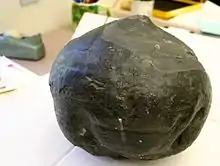Adolf Carl Noé
Adolf Carl Noé (born Adolf Carl Noé von Archenegg; October 28, 1873 – April 10, 1939) was an Austrian-born paleobotanist. He is credited for identifying the first coal ball in the United States in 1922,[1] which renewed interest in them. He also developed a method of peeling coal balls using nitrocellulose.[2] Many of the paleobotanical materials owned by the University of Chicago's Walker Museum were provided by Noé, where he was also a curator of fossil plants.[3] He was also a research associate at the Field Museum of Natural History, where he assisted with their reconstruction of a Carboniferous forest.[4]
Adolf Carl Noé | |
|---|---|
| Born | Adolf Carl Noé von Archenegg October 28, 1873 |
| Died | April 10, 1939 (aged 65) |
| Alma mater | University of Chicago |
| Known for | Coal ball and paleobotanical studies |
| Spouse(s) | Mary Evelyn Cullatin |
Biography
Early years
From 1894 to 1897, Noé attended the University of Graz,[5] studying paleobotany under Constantin von Ettingshausen.[6] After Ettinghausen's death, Noé moved to Germany in 1897, having been transferred to the University of Göttingen.[7] While a young man, Noé served briefly in the cavalry as a member of the 8th Austrian Hussars.[8]
He studied there until 1899, when he moved to the United States.[8] During that year, Noé began his work at the University of Chicago.[5] He obtained a B. A. in 1900.[5] Later in that year Noé married the former Mary Evelyn Cullatin. The pair had two daughters, Mary Helen Noé (who later married Nobel laureate Robert S. Mulliken) and Valerie Noé.[5]
In 1901, he moved to California to teach German at Stanford University.[5] Four years later, in 1905, Noé earned a Ph.D. in Germanic Languages and Literatures.[9]
Noé taught at the University of Chicago from the 1910s, continuing his interest in the mounted soldiery as member of the 1st Illinois Cavalry in 1915 and 1916, during which he attended training camps at Fort Sheridan and Plattsburg.[8]
Near the end of World War I, Noé removed "von Archenegg" from his name to avoid anti-German sentiment.[4][5] Noé also stopped teaching German classes to research paleobotany, due to overstaffing and the public's disinterest in taking the German courses.[4] Following the war, Noé participated in reconstruction efforts in his native Austria, work for which he was awarded a gold medal from the University of Vienna and the gold cross of honor from the government of the Republic of Austria.[8]
Paleobotanical work

Noé became a geologist for the Allan and Garcia Coal Commission in the Soviet Union in 1927, ten years after the October Revolution. There, in the Donetz coal basin, Noé did work as a mining geologist,[10] where he fulfilled a contract granted by the Soviet government assessing the state of coal production in the region.[8] Upon his return to the United States he published a memoir of his journey, Golden Days of Soviet Russia.
In 1934, Noé became the Field Museum of Natural History's research associate, and assisted in the construction of a Pennsylvanian coal swamp there.[1]
Studies on coal balls
Coal balls in North America were found in Iowa coal seams since the 1890s,[10] although the connection to European coal balls was not made until Noé (whose coal ball was actually found by Gilbert Cady[1][10][11]) drew the parallel in 1922.[12] There was some disbelief over Noé's discovery.[10] For instance, in 1922, Noé was contacted by David White, who strongly believed that coal balls could not be found in North America.[10] Noé later managed to convince him otherwise by showing him a wheelbarrow full of Illinois coal balls, after which White never spoke to Noé again.[10]
References
- Leighton & Peppers 2011
- Kraus 1939, p. 231
- Croneis 1939, p. 380
- University of Chicago Library 2006, p. 4
- Darrah & Lyons 1995, p. 175
- Andrews 1951, p. 441
- Andrews 1980, p. 237
- Adolf Carl Noé, Golden Days of Soviet Russia. Chicago: Thomas S. Rockwell Co., 1927; biographical information on inside dust jacket flap.
- Croneis 1939, p. 379
- Darrah & Lyons 1995, p. 176
- Andrews 1951, p. 440
- Noé 1923, p. 385
- Darrah & Lyons 1995, p. 179
Bibliography
- Croneis, Carey (28 April 1939). "Adolf Carl Noé". Science. New Series. American Association for the Advancement of Science. 89 (2313): 379–380. doi:10.1126/science.89.2313.378. JSTOR 1665330.
- Kraus, E. J. (September 1939). "Adolf Carl Noe". Botanical Gazette. University of Chicago Press. 101 (1): 231. Bibcode:1939Sci....89..379C. doi:10.1086/334861. JSTOR 2472034.
- Leighton, Morris W.; Peppers, Russel A. (16 May 2011). "ISGS - Our Heritage - A Memorial: Adolf C. Noé". University of Illinois Board of Trustees. Archived from the original on 2012-02-11. Retrieved 2012-02-04.
- Phillips, Tom L.; Pfefferkorn, Herman L.; Peppers, Russel A. (1973). "Development of Paleobotany in the Illinois Basin" (PDF). Illinois State Geological Survey. Archived from the original (PDF) on 11 February 2012. Retrieved 15 September 2011.
- Darrah, William Culp; Lyons, Paul C. (1995). Historical Perspective of Early Twentieth Century Carboniferous Paleobotany in North America. United States of America: Geological Society of America. ISBN 0-8137-1185-1.
- "Guide to the Adolf Carl Noé Papers 1892-1939" (PDF). University of Chicago Library. 2006. Archived (PDF) from the original on 11 February 2012. Retrieved 11 February 2012.
- Andrews, Henry N.; Jr (June 1951). "American Coal-Ball Floras". Botanical Review. Springer Science+Business Media on behalf of New York Botanical Garden Press. 17 (6): 431–469. doi:10.1007/BF02879039. JSTOR 4353462.
- Noé, Adolph C. (30 March 1923). "Coal Balls". Science. American Association for the Advancement of Science. 57 (1474): 385. Bibcode:1923Sci....57..385N. doi:10.1126/science.57.1474.385. JSTOR 1648633. PMID 17748916.
- Andrews, Henry N. (1980). The Fossil Hunters: In Search of Ancient Plants. Cornell University Press. ISBN 0-8014-1248-X. OCLC 251684423.